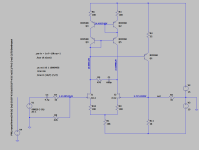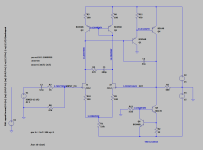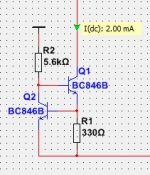Notice 2.2Meg resistor forms virtual ground with two 47k resistors. Tied to GND with the other end.Yes, it will.
Great application note on ls844 jfets https://www.linearsystems.com/_files/ugd/7e8069_fa391910f8284bdda674c2dff39db8d1.pdf
I’ll add jumper there to GNDI think that 2.2M resistor does nothing.
Connect GND directly between those two 47k
I wonder how much distortion can be improved by adding that other CCS for 2mA? I want to run it in sim just to see if it’s worth it…This is how you can add those 2 Constant Current Sources, CCS.
They are like 2mA and 25mA.
I wonder if there is a way to improve on THD performance further, or if this is physical limitations that cannot be stepped over?
Increase in common mode impedance?I think that 2.2M resistor does nothing.
Connect GND directly between those two 47k
Replacing R1 with a current source will surely improve THD.I wonder if there is a way to improve on THD performance further, or if this is physical limitations that cannot be stepped over?
Say 2.5mA or 5mA something
Last edited:
2ma all is needed.
5ma will cause instability
actually just 3ma will
you could add a current source.
on regulated 15 volt rails.
its little different and easier to get constant current.
if you planned on changing voltage or needed wide range of voltage
then yes.
long as voltage is constant then so is current.
5ma will cause instability
actually just 3ma will
you could add a current source.
on regulated 15 volt rails.
its little different and easier to get constant current.
if you planned on changing voltage or needed wide range of voltage
then yes.
long as voltage is constant then so is current.
Very easy, LM7171 is specifically designed for ADC/DAC systems.I wonder if there is a way to improve on THD performance further, or if this is physical limitations that cannot be stepped over?
And can source up to 100ma of current. specifically designed to drive 600 ohm transformers
Unity Bandwidth of 200 MHz and a slew rate of 4100 V/us and current output of 100ma
not a type error slew rate at 4K
TI and National Semi before them are the leaders of special PNP transistors lateral and bipolar.
to reach un heard of speed and bandwidth into high current loads
it will drive 600 ohms at .0004% distortion
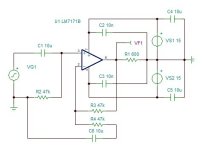
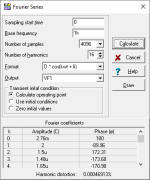
If you want very low noise and very high input impedance
then add a discrete Fet input. To increase bandwidth, can use a cascode.
To reduce noise even further we can lower the voltage to
the Fet using a Cascode referenced at 7 volts.
While the opamp has full output to 600 ohms at 30 volts.
Another benefit is making it driven cascode which adds a additional
feedback with R9. additional feedback and extremely low noise
brings distortion even lower to .0002 %
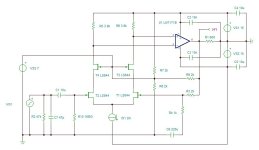
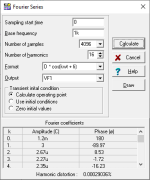
then add a discrete Fet input. To increase bandwidth, can use a cascode.
To reduce noise even further we can lower the voltage to
the Fet using a Cascode referenced at 7 volts.
While the opamp has full output to 600 ohms at 30 volts.
Another benefit is making it driven cascode which adds a additional
feedback with R9. additional feedback and extremely low noise
brings distortion even lower to .0002 %


Will it improve THD as well? I’m just new to this so wondering about that. Is it good idea to use it in the design with tp140/139?To increase bandwidth, can use a cascode.
jfet input is mainly for low noise, high impedance.
even though LS844 and many other fets can tolerate
maybe 40 volts.
To dramatically reduces noise you lower the voltage.
And a simple cascode can allow lower voltage.
Or if this was a high power amp with 60 volts or more
we would have to lower the Fet voltage anyways.
you can even use a low noise BJT for the cascode.
but going all fet. yes will reduce noise even more.
cascode will improve bandwidth and lower noise
so yes les total THD since THD plus Noise analysis
will be great. Since a real THD measurement should
include noise.
Since parts count is what it is. and the cascode already there
might as well toss in a few resistors since you can run additional
feedback as well. Which yes also reduces THD
the additional feedback and bandwidth would help
THD at 20 kHz those numbers are at 1 kHz
but all together even at THD 1k additional feedback
brought it down from .0004% to .0002%
even though LS844 and many other fets can tolerate
maybe 40 volts.
To dramatically reduces noise you lower the voltage.
And a simple cascode can allow lower voltage.
Or if this was a high power amp with 60 volts or more
we would have to lower the Fet voltage anyways.
you can even use a low noise BJT for the cascode.
but going all fet. yes will reduce noise even more.
cascode will improve bandwidth and lower noise
so yes les total THD since THD plus Noise analysis
will be great. Since a real THD measurement should
include noise.
Since parts count is what it is. and the cascode already there
might as well toss in a few resistors since you can run additional
feedback as well. Which yes also reduces THD
the additional feedback and bandwidth would help
THD at 20 kHz those numbers are at 1 kHz
but all together even at THD 1k additional feedback
brought it down from .0004% to .0002%
Now I wonder how are they different, j111, j112, j113?You should go for J113
- Home
- Source & Line
- Analog Line Level
- Need help simulating discrete impedance matching buffer in LTSpice - using 2N7002 and BC856
